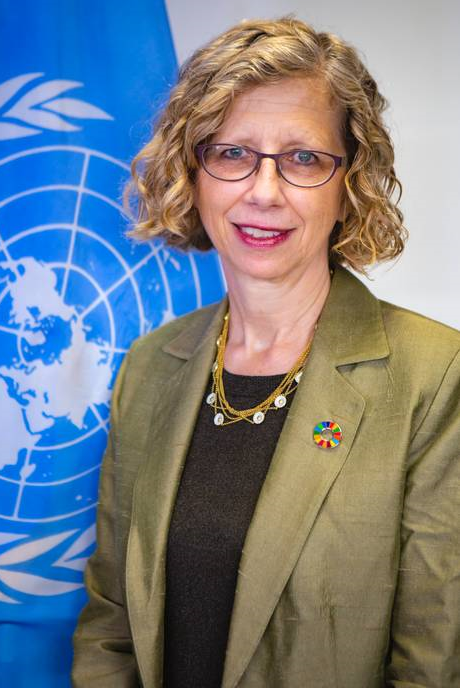我们不应把“恢复常态”当作目标
作者:IFF研究院
来源:国际金融论坛(IFF)
时间:2020-06-18

联合国副秘书长、亚太经社会执行秘书阿里沙赫巴纳女士

联合国副秘书长、环境规划署执行主任安德森女士
新冠病毒Covid-19爆发之前的世界现在看来似乎是很吸引人的。当前我们面对疾病蔓延、大规模失业、保持社交距离的现状,回归疫情前的常态听起来似乎是令人期盼的。但是,我们应当记住那个“常态”曾经是什么样的。
那个“常态”是:我们使用的能源,85%都来自化石燃料,每年有7百万人死于空气污染。
那个“常态”是:到本世纪末,全球气温将逐步升高3.5摄氏度,岛屿国家将面临消失的危险。
那个“常态”是:每8个物种中就有1个物种面临灭绝的危险,野生动植物生存空间被挤压到越来越小的空间,野生动植物非法贸易猖獗。
是那个“常态”间接地导致了这场冠状病毒疫情。
我们也不要忘记,新冠病毒Covid-19给公共卫生、就业和经济带来的影响,其实这仅仅是我们当初曾经预计到的气候变化导致后果的一种急性症状,这样的状况在很多地方已经出现多次。如果我们不是追求重建一个“更好的常态”,那么我们就只是在处理“病症”,而不是对症下药根治疾病(译注:换句话说就是“治标不治本”)。因此,我们必须更美好地重建。
许多国家政府已经在准备经济刺激计划和救助计划以支持疫情后的复苏。预计将有上万亿美元注入亚太地区的经济。这些刺激计划应当帮助我们努力实现一个更好的常态——一个更加绿色、更加公平的常态。如何实现呢?最近对53个国家230名经济学家的一项调查显示,绿色气候友好型经济刺激措施是重振经济的最佳选择,无论从长期还是短期来看,都能产生最大的经济效益。
即使在疫情前,联合国有关报告的数据显示,气候行动到2030年能够撬动26万亿美元的经济效益、创造超过6500万个新的就业岗位,使70万人免于因空气污染而缩短寿命。各国政府在制定绿色、公平的经济刺激措施时不会缺少可选择的方案:比如他们可以选择支持建筑行业建造一些高能效、零耗能的建筑,这是一个劳动密集型行业,投资也可以很快进入实施。
大规模投资于公路这样的基础设施也很吸引人,但其实资金可以投向改善后的更加绿色的公共交通系统,以服务到更多人群。更大承载能力的公共交通系统可以减少路面交通,从而降低空气污染并减少碳排放。疫情期间的隔离和封闭措施也显示了我们可以依赖信息技术来分散企业的运营,这样也减少了通勤和出差时间,相应降低了碳排放。各国政府现在应当考虑对那些投资于用信息技术解决运营方案的企业给予奖励。
很多行业都在寻求政府的救助和纾困方案以尽快恢复。没有比现在更好的时机了:政府应对此附加一些条件,要求企业朝着气候中和的方向努力。比如,应当要求收到政府支持的航空公司做出更多的承诺,采取更有效的措施,减少排放,这也是航空业长期可持续发展、保障数百万人就业所必须的。有一些政府已经率先做出的榜样,要求航空业设置能源效率目标、由铁路运输代替短途航班,在此基础之上为行业提供支持。
对汽车行业的救助纾困计划可以将投资转向电动汽车、电池生产以及高效技术,而不应该救助化石燃料产业。亚洲发展中国家占全球化石燃料补贴的近三分之一。在疫情后的重建阶段是终止这类补贴的最好时机,并确保煤炭行业不再获得新的投资。政府可以把那些投资转向支持公共卫生、可再生能源这样的领域,这也就回答了政府刺激计划所需的资金来自于哪里这样一个问题。
纵观亚太地区,各国政府的财力不可能满足经济恢复所需的这样规模的资金体量。这就需要将现有的资源重点用于能够产生最大经济效益的政策上。这也表明我们的当务之急是寻找新的收入来源。
当前这个时机,对碳排放征收费用、改革农业和化石能源补贴都将取得良好成效,因为现在原油价格正处于低位,此时取消补贴所产生的社会影响将会相对较小。类似于“节能补助计划”(feebates)-- --政府对高碳排放汽车收较高的费而对低碳排放车返还一部分费----的刺激措施,能够推动更加绿色的交通发展、提高能源效率,也为政府增加税收提供了更多选择。
绿色债券也可以成为提高能效项目和可再生能源项目的融资来源。在亚太地区,除了中国、日本和韩国之外,其他国家和地区鲜有绿色债券发行。现在我们应当利用这个已被证实有效的金融理念,来支持疫情后可持续的、恢复力强的复苏。
新冠病毒Covid-19是自然传递给我们的一个讯息。持续的气候危机也是来自自然的讯息。“常态”是不可行的,我们必须更好地重建。
(注:根据英文稿翻译,本文由联合国环境署中国首代、国际金融论坛全球绿色增长中心特邀高级顾问涂瑞和先生提供)
We should not aim to return to normal
Armida Alisjahbana and Inger Andersen
The world before COVID-19 looks very attractive right now. In light of the disease, mass unemployment and social distancing, a return to pre-pandemic normality seems appealing. Yet we should remember what normal was.
Normal was obtaining 85 per cent of our energy from fossil fuels and losing 7 million people a year to air pollution.
Normal was careening toward a global temperature rise of over 3.5 C by the end of the century, with island nations facing obliteration.
Normal was 1 in 8 species threatened with extinction, continued squeezing of wild spaces into smaller and smaller corners, and the rampant illegal trade in wildlife.
Normal contributed to causing this pandemic.
We should also remember that COVID-19’s effects on health, jobs and economies are simply an acute version of what climate change is predicted to bring – and in places already has. Unless we aspire to a better normal with recovery, we are treating the symptom, not the disease. We must build back better than before.
Many governments are preparing stimulus and relief packages to support COVID-19 recovery. Trillions of dollars will be ushered into the economy across Asia and the Pacific. These stimulus measures should help us achieve a better normal – a greener, more equitable normal. How? A recent survey of 230 economists in 53 countries suggests that green, climate-friendly stimulus measures are the best options for an economic rebound, offering the highest economic multipliers in the short- and long-terms.
Even before the pandemic, the UN determined that climate action could trigger $26 trillion in economic benefits by 2030, create more than 65 million new jobs and avoid 700,000 premature deaths from air pollution. Governments have no shortage of options when it comes to directing a green, equitable stimulus package. They can offer support to the construction industry to develop energy efficient and zero-energy buildings. This is a high employment sector, and investments can be quickly implemented.
It may be tempting to scale up funds for infrastructure like roads, but that funding can go to improved and greener public transport systems to service more people. More public transit capacity will reduce the load on roads and reduce air pollution and emissions. The lockdown has shown it’s possible to lean more heavily on IT to decentralize business operations, reducing time lost and carbon produced in commutes and travel. Governments should now consider incentives to companies that invest in IT solutions for their operations.
Many industries will be looking for bailouts to bounce back. There is no time like the present for governments to include terms that will require companies to work toward climate neutrality. Airlines supported by governments should be asked to make stronger commitments and take bolder action to reduce emissions, which will be needed anyway for the industry to guarantee long-term sustainability and employment for the millions who rely on it. The example is being set by those governments who have made their support dependent on energy efficiency targets and shifting short haul flights to rail.
Bailouts to the auto industry can be directed to investments in e-vehicle and battery production, and efficiency technology. Where bailouts should not happen is in the fossil fuel sector. Developing Asian countries account for nearly one-third of global fossil fuel subsidies. The COVID-19 recovery period is the right time to end these subsidies, and ensure there are no new investments in coal. The savings to governments can support investments in areas like public health and renewable energy. This is one answer to the question of where stimulus money will come from.
Across Asia and the Pacific, governments have scarce financial resources to apply toward recovery measures at the scale needed. This underlines that existing resources must be deployed to policies with the highest economic multipliers. It also implies that finding additional revenue will be a priority.
Putting a price on carbon emissions and reforming subsidies for agriculture and fossil fuels can be especially effective with oil prices at record lows, when the social impact of removing subsidies will be lessened. Measures like feebates – which impose a fee on high-carbon vehicles and give a rebate to low-carbon cars - to incentivize greener transport and energy efficiency improvements provide more options for increasing revenue.
Green bonds can also finance energy efficiency and renewable energy projects. Outside China, Japan and the Republic of Korea, green bonds are scarce in the region. Now is the time to capitalize on a proven idea to support a sustainable and resilient recovery from COVID-19.
COVID-19 is a message from nature. So is the ongoing climate crisis. Normal isn’t working. We need to build back better.
(Armida Alisjahbana, UN Undersecretary General, the Executive Secretary of the UN Economic and Social Commission for Asia and the Pacific
Inger Andersen, UN Undersecretary General, the Executive Director of the UN Environment Programme)